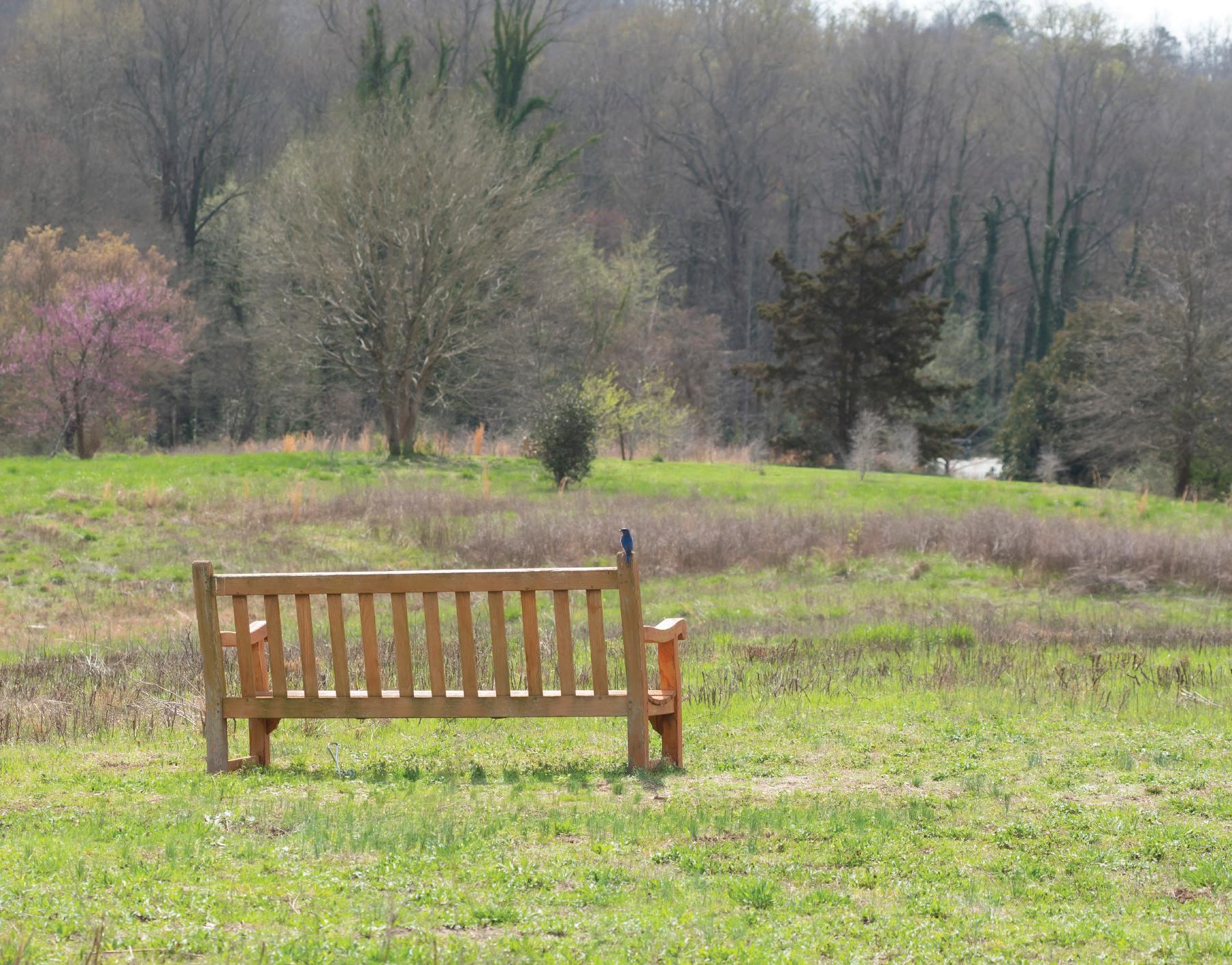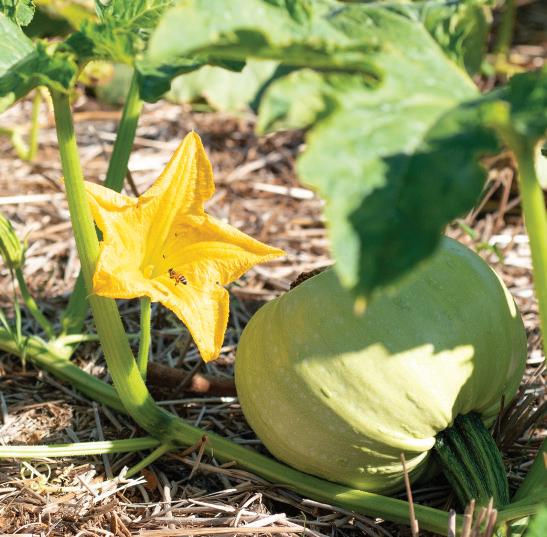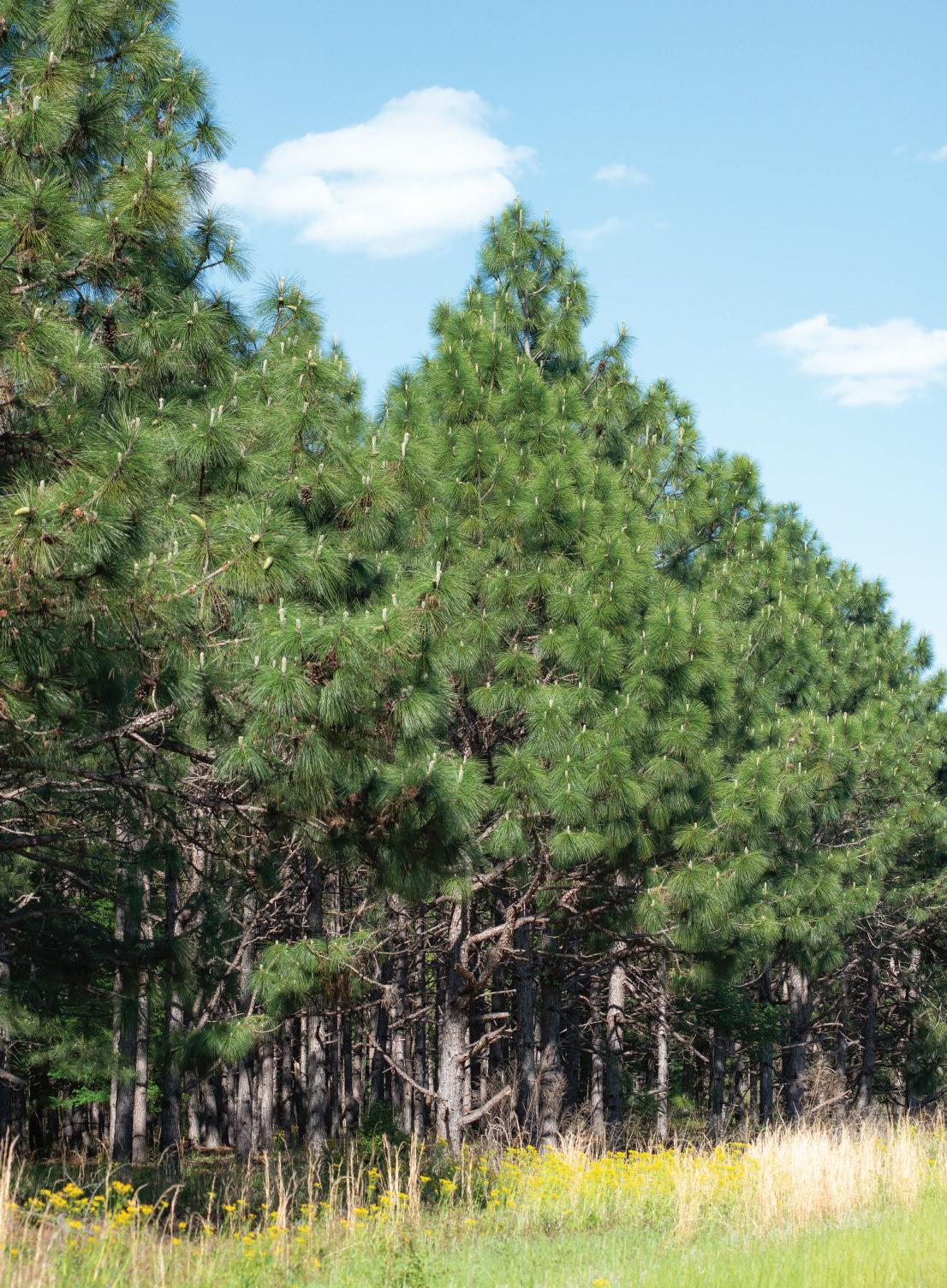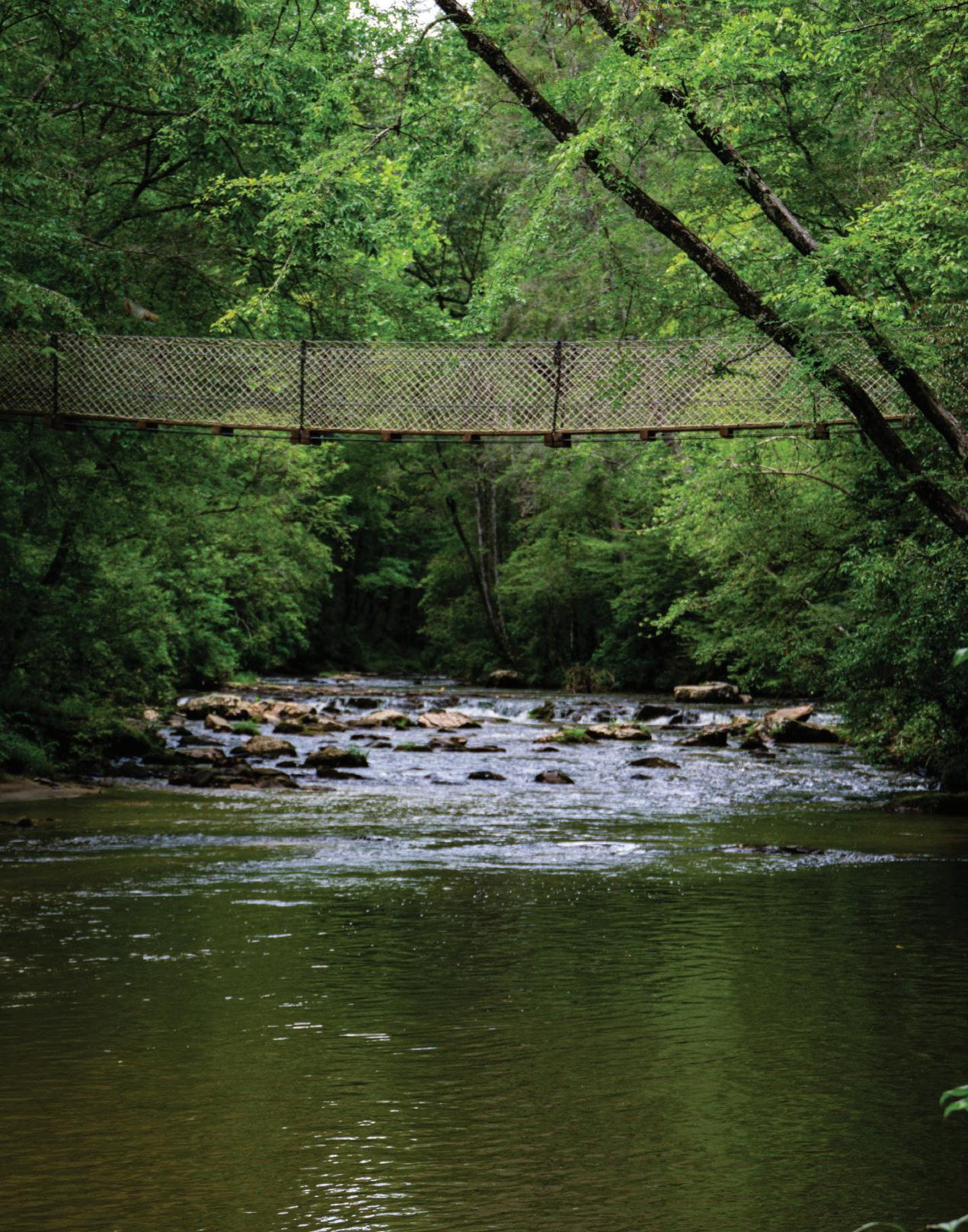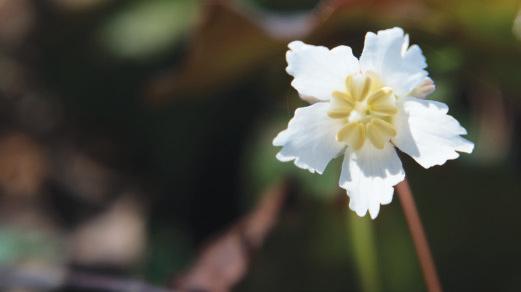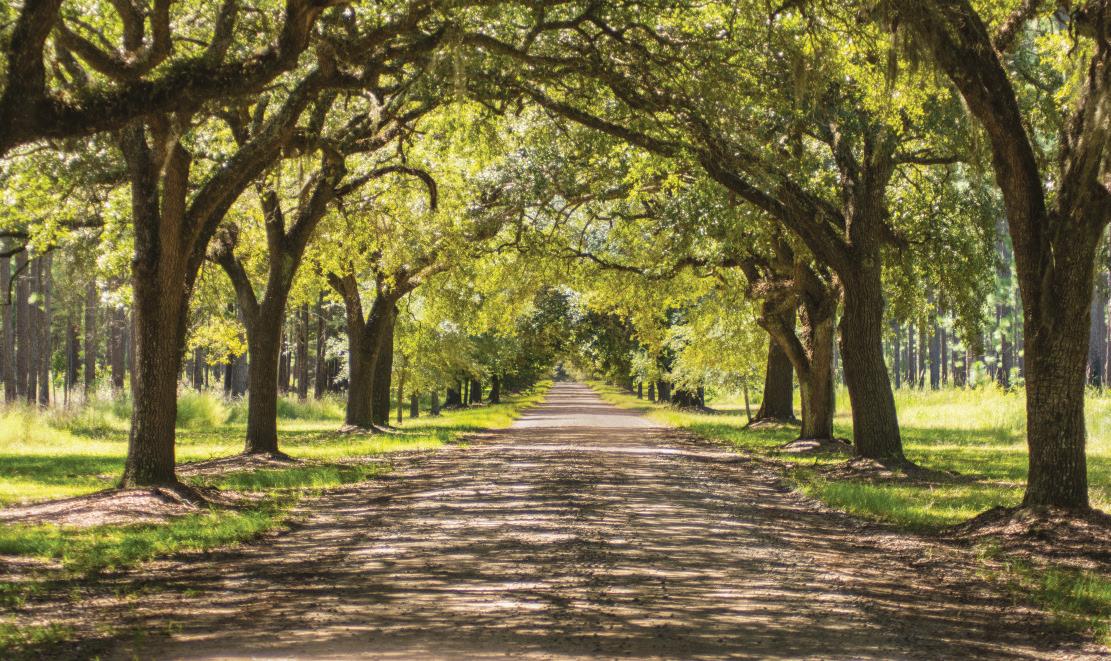D irections
“I DON’T KNOW WHO MY GRANDFATHER WAS; I AM MUCH MORE CONCERNED TO KNOW WHAT HIS GRANDSON WILL BE." – ABRAHAM LINCOLN
2024 is a noteworthy year in the life of SCDNR. In addition to celebrating seventy years of South Carolina Wildlife, this year we also mark fifty years of the South Carolina Heritage Trust program. Since its birth in 1974, the South Carolina Heritage Trust Program has worked to identify, evaluate, and protect the natural and cultural resources considered to be the most outstanding representatives of the State’s natural and cultural heritage. Here in 2024, as we march towards summer and anticipate spending more time outdoors with friends and family, I’m thinking of our forebears’ inspired vision to set aside our most special places under the ground-breaking Heritage Trust program. I’m also wondering about our own legacies and how our contemporaries will be remembered for our stewardship of South Carolina’s natural and cultural resources in the first quarter of the twenty-first century. I find some comfort in the message in the words of our sixteenth U.S. President—an implied reminder that rather than fuss over the past, we should all strive to do our best and be our best in order the secure our future. What a great way to consider how we’ll spend our summer.
Governor John C. West inaugurated the South Carolina Heritage Trust Program in February 1974. This effort was the first of its kind in the nation to preserve and protect natural and cultural properties across the Palmetto State. What began in the mid-1970s as the state’s population was about to explode spurred a movement within the United States and across the western hemisphere for the creation of programs to protect significant natural areas, to set them aside for current and future generations to study, explore, and enjoy. Today, South Carolina remains a state of rich natural and cultural resources, including habitats for rare and critically imperiled species of global importance, and is home to diverse and vibrant cultures who have shaped the landscape since time immemorial as revealed through archaeology and the historic record. Today, SCDNR is pleased to provide long-term stewardship and protection in perpetuity for nearly 106,000 acres in 81 Heritage Trust properties across the Palmetto State. These places secure a legacy we will leave for the future as these special properties are protected in perpetuity.
I often say “conservation is a team sport.” With that in mind, I’d like to tip our hat to our forebears and our partners for their unwavering support for the Heritage Trust Program throughout its history. Reflecting on the Heritage Trust program’s fifty years, and mindful that we should not take today for granted (to say nothing of looking too far ahead and worrying about our legacy), I’m reminded that “the future belongs to those who tell the best stories.” As seventy years of South Carolina Wildlife will attest, we have some amazing storytellers whose words, photos and art have graced these pages over the past seven decades. As we have for the past sixty-nine summers, we are pleased to offer a glimpse of some of the best of South Carolina’s summer outdoor activities in hopes that you will be inspired to get out this summer and enjoy the Palmetto State and consider, as Abraham Lincoln suggested, who we will be.

— Robert H. Boyles Jr., Director South Carolina Department of Natural Resources
YAWKEY WILDLIFE CENTER
Dawn Chorus BY CINDY THOMPSON
The dawn chorus begins just before sunrise. Sparrows, finches, wrens and a myriad of other land birds fill the air with passionate songs, welcoming the new day with fervor.
Vast expanses of swaying spartina in the salt marsh catch the first rays of light. Red-winged blackbirds cling to tall reeds and cattails, zealously defending their territory. CONK-LA-REEEEEE!
Gradually, warm beams extend and cloak upland forests, stirring brown-headed nuthatches to begin their daily forage. They dart from pine to pine, squeaking CHEE-AA! CHEE-AA!
The sun’s rays reveal tannin-stained rivers, swiftly sculpting sandbars and bluffs with each twist and turn. Brightly feathered prothonotary warblers TWEET repeatedly from their hideouts in the cypress trees and knotty knees.
Rolling onward to higher elevations, the rising sun paints mountain peaks and valleys with a broad brush of color. Skittish Carolina chickadees call out FEE BAY! FEE BAY! They appear momentarily from the safety of leafy limbs to snatch seeds from flowering fields below.
Morning Has Broken
A cup of hot coffee is poured while the faint, distant hum of engines, machines, horns and sirens grows louder. The clock ticks forward.
Perched atop the front porch rail, a Carolina wren sings out TEAKETTLE! TEAKETTLE! TEAKETTLE! The front door swings open, and the chunky little visitor quickly disappears amidst a cluster of azaleas.
The commute begins, same as it ever was, but today the roadside panorama is starkly different. Seemingly overnight, stately forests, sprouting farm fields and tranquil fishing holes have been dissected and swallowed up by concrete and metal. Massive buildings, warehouses and solar devices have materialized out of thin air, blanketing the rolling terrain.
Now, caught in a steady stream of automobiles and in the crosshairs of property prospectors, nature’s dawn chorus is all but forgotten. The pressure to fold up and sell seems unrelenting. Letters, emails, texts and phone calls inquire about the home site. The land. The water. The farm. The town. Has the tipping point arrived?
A Sense of Place
The theme of the SCW January-February 2000 edition, A Sense of Place, was selected in response to stressors on the environment that were occurring more than two decades ago. Page one reads: “South Carolina Wildlife magazine dedicates this special issue to the preservation of all creatures and the natural habitats that sustain them.” Pointedly, at the onset of a new millennium, then SCW Editor John Davis wrote, “Our love of the land is fierce, our belief in the independence of the individual unshakable. Products of an agrarian society wilting under the heat of change, we are eager to bask in the wealth of development, yet desperate to hold onto our Southern roots — our sense of place.”
This issue, the summer 2024 edition of SCW magazine, revisits this theme at a pivotal time. Cruising Carolina’s scenic backroads,
DRAPER WMA STRAWBERRIES AT COTTLE STRAWBERRY FARM
nowadays, it’s even more common to see drastic alterations across the landscape. Vast acres of coastal marshlands, fertile farm fields, grassy open spaces and diverse forest types have disappeared at an alarming rate. According to the U.S. Census, between July 2022 and July 2023 an increase of 1.7 percent, more than 90,000 people, moved to South Carolina. This number of people is greater than the current population of Greenville or Rock Hill. Our state now leads the nation in population growth.
As the call for conservation and sustainability grows louder, so does the demand for commerce and development. People need a new this and a new that, and they need it in a hurry. Yet, natural resources, ecosystems, plants and wildlife take time to replenish and rebound. And this required lag time is not fast enough for the demands of the world. There is a limit. Is it possible for conservation and development to coexist in a sustainable way? The time to “hit the pause button” and talk . . . is today.
Grassroots Conservation
Despite all the conveniences of a drive-through restaurant and a fully-loaded superstore, we long for that “sense of place.” We pine for pluff mud, flowering meadows, fields of gold, forested hillsides, swirling rivers and cascading waterfalls. Yet, caught in a frenzy to compete and sell land to the highest bidder, what are we willing to lose? Can we hold on to the vast array of plants, wildlife and ecosystems that drew us to love South Carolina in the first place?
For a moment, let’s reflect on three major milestones in history that have perhaps set the stage for conservation conversations today.
During the late 1800s and early 1900s, America’s first national and state parks were secured and shielded from future development. These majestic natural vistas amassed even greater support for conservation, strengthening partnerships among nonprofit organizations, landowners, scientists and government entities.
On April 22, 1970, towns and cities across the country paused to celebrate nature’s good work, and people joined together to talk about the environment. This was our nation’s first official Earth Day. Today, fifty-four years later, two hundred countries or more have joined the celebration. Complicated conservation challenges have been addressed over time, such as pollution, deforestation, climate change, dwindling biodiversity, and pathways to sustainability.
In South Carolina, during the 1980s and 1990s, significant and vital ecosystems within the ACE Basin and the Jim Timmerman Natural Resources Area of Jocassee Gorges were safeguarded — permanently protected from widescale development. These top-tier examples of land conservation were made possible through local grass-roots support, forwardthinking advocates and partnering groups who all dared to say no to future development. In order to accomplish such broad protection efforts, strong safety nets were woven together, piece by piece, to assist landowners in these regions. Partnerships were forged in the form of conservation easements, management agreements, cost-share programs and generous donations. A new ground-up approach to conservation was devised, and history was in the making.
PUMPKINS AT COTTON HILLS FARM
May the Forest Be with You
Addressing the challenges of urbanization during his presidency, Franklin Roosevelt’s words still resonate today, “A nation that destroys its soils destroys itself. Forests are the lungs of our land, purifying the air and giving fresh strength to our people.”
Trees! They strengthen markets and supply chains, connect people to nature, provide oxygen, carbon storage, biodiversity, and add value to land. The National Association of Conservation Districts (NACD) recently celebrated its 69th Annual Stewardship Week from April 28 to May 5. This year’s theme, “May the Forest Be with You, Always,” explored relationships between soil and water conservation and the resilience of forests.
The S.C. Association of Conservation Districts (SCACD) planned forestry-themed events during Stewardship Week, including a field day at Harbison State Forest. Breakout sessions and field trips covered conservation easements, forest stewardship plans, cost share programs, prescribed fire resources, and agribusiness opportunities.
There are 12.8 million acres of forestland in the Palmetto State, according to the S.C. Forestry Association, and more than 11 million acres are privately owned. The toolbox for wise land management is overflowing, however, the outcome heavily depends on the situation and the inclination of the individual. During SCACD’s forestry field day, one landowner put it this way, “I may pay taxes on the land, but I will never truly own it. I’m just taking care of this land while I’m here.”
Conservation Conversation
On Earth Day, April 22, 2024, the Palmetto Foundation hosted a Conservation Conversation panel discussion at Nickelodeon Theater on Main Street, Columbia. The panel of speakers represented The Nature Conservancy, Mast General Store, The Foothills Trail, S.C. Wildlife Federation, SCPRT, Francis Marion National Forest, S.C. Conservation Bank and Congaree Land Trust. It was a packed house, and the panel covered a lot of ground. Audience questions led to discussions about solar panels, Native American representation, conservation easements and more.
A few days after the Palmetto Foundation Earth Day event, SCW magazine continued the conservation conversation with The Nature Conservancy (TNC) Upstate Conservation Director Kristen Austin, Congaree Land Trust (CLT) Land Protection Director Mary Crockett and S.C. Conservation Bank (SCCB) Executive Director Raleigh West.
Kristen Austin serves as upstate conservation director of The Nature Conservancy (TNC), a global conservation nonprofit whose mission is to conserve lands and waters in which all life depends. The international organization works alongside conservation partners and communities to find science-based solutions to habitat loss and impacts from a changing climate.
Austin and her colleagues are working at a fast pace to stay ahead of the curve, but leading up to this special issue of SCW magazine, we locked in on an hour of time to talk by phone.
Balancing conservation and development is a world-wide
EASTERN WILD TURKEY AT BOONE HALL PLANTATION AND GARDENS
concern, and a challenge we are experiencing in South Carolina as well. How does TNC employ assistance at both the global and local level?
“Whether TNC is working on the continent of Africa in Kenya, or throughout South Carolina, science determines where we focus and collaboration guides how we achieve lasting results,” Austin said. “Grounded by decades of local on-theground experience, we maximize our ability to affect change by bringing together real-world solutions, policy expertise, sustainable financing, and collaborative partnerships. TNC has been working in South Carolina for fifty-five years, and the secret to any conservation success we’ve had is rooted in working with landowners and local communities to find solutions so people and nature thrive together.”
How do we work together to map out a plan?
“In South Carolina, TNC and our partners have taken the best available data showing critical lands and water to create the South Carolina Conservation Vision Map,” Austin responded. “Any good map guides where to go. The ‘Vision Map’ shows thirty percent of South Carolina needs some level of conservation protection.”
Recent U.S. Census data notes that South Carolina was the
fastest growing state in 2023 based on the highest percentage increase in the country. Currently, 15.24 percent of South Carolina is conserved through conservation easements and lands owned by conservation entities such as federal and state agencies and private organizations.
Austin asserts, “It is time to double the pace and scale of conserving special places around the Palmetto State for future generations. This effort will take all hands on deck through landowners, local communities, businesses and conservation groups coming together to share this common vision and work together for a sustainable South Carolina.”
One key example is in Laurens County, an Upstate county feeling the pressures of growth coming from surrounding counties. According to Austin, TNC purchased approximately 2,300 acres near the community of Joanna, and has partnered with Laurens County, whose county council voted to establish a new county park with an equestrian focus to bring recreational opportunity and new revenue streams to the area. TNC will be working with the U.S. Forest Service to expand the Enoree District of the Sumter National Forest and allow for more public access with the remainder of the property.
WANDO RIVER
TOM YAWKEY WILDLIFE CENTER HP
Mary Crockett is well-known for building partnerships to protect river corridors. Over the years, through her former role at SCDNR and today with the Congaree Land Trust (CLT), she has been instrumental in setting up safeguards for our state’s scenic rivers. As Congaree Land Trust’s land protection director, she facilitates conservation easements, which shores up additional protection for South Carolina’s watersheds.
Crockett and I caught up by telephone as well, addressing topics covered at the recent Conservation Conversation panel discussion. “It’s common to see land become a parking lot, solar farm, high rise or split into little bitty plots. But this is not always the case,” Crockett said. “Easements have been coming in at a steady pace since I’ve been here.”
As opportunities arise, the Congaree Land Trust assists landowners and farmers who are seeking long-term conservation avenues. “There has to be a will to want to see the land stay in its natural condition, or in agriculture or as a tree farm.”
Crockett explained the process of entering into a conservation agreement. “Easements follow the land not the landowner. They provide the final management plan for that land. Once the easement is written up and signed by the landowner, trust, organization, agency or municipality involved, the successive landowners have to abide by that document forever. Most allow for agriculture and silviculture to continue forever with little development.”
Crockett advises landowners to first consult with their attorney or certified public accountant. There are tax incentives in estate planning. Land trust organizations and government agencies are available to assist.
Looking at conservation easements from a bird’s eye view, Crockett explained that larger fauna need these expansive ranges, and large acreage is a good thing. Heat maps are coordinated across all agencies, she added.
Raleigh West recalls riding by the dove field in Berkeley County where he used to go hunting as a kid. The Lowcountry farm had folded and was replaced by industrial buildings and warehouses.
That scene left West feeling sad and frustrated. He could clearly understand the long hours, hard work and monetary investments the landowner must have poured into that farmland. However, the conversion of his boyhood hunting grounds, swallowed by development, was jarring. This may have been a turning point for him.
Today, West serves as executive director of the South Carolina Conservation Bank (SCCB), an arm of state government designed to improve quality of life through the conservation of significant natural lands, wetlands, historical properties, archeological sites and urban parks. In his role at the Conservation Bank, West works with partnering groups to facilitate land easements and acquisitions. Various funding mechanisms are engaged, and agreements are tailored to the landowner’s wishes or the situation.
SALUDA RIVER; S.C. CONSERVATION BANK EXECUTIVE DIRECTOR RALEIGH WEST
RED-WINGED BLACKBIRDS
DONNELLEY WMA
EASTERN TIGER SWALLOWTAIL
West’s boots-on-the-ground approach leads him to far-reaching corners of the Palmetto State — meeting with landowners and visiting tracts of land to solidify easements.
During our conservation conversation, overlooking the Saluda River in downtown Columbia, West bulleted a timeline of milestones that set the stage for South Carolina’s successful “ground up” approaches to land protection. The monumental protection of national parks and forests during the 1800s segued to the formation of state parks, forestry lands, refuges, heritage preserves and wildlife management areas during the 1900s. But countless parcels of agricultural lands and wildlife meccas were still falling through the cracks. The groundbreaking protection of contiguous lands within the ACE Basin and Jim Timmerman Natural Resources Area of Jocassee Gorges during the 1990s opened doors to innovative strategies in land conservation — a grass-roots, all hands-on-deck approach. West pointed out that new tax codes were structured to better assist in conservation, and this helped fast-track agreements and easements during those years. And then, the S.C. Conservation Bank arrived on the scene in 2002.
“A rush of donors stepped in to help,” West said. “And these landowners tended to be extremely conservation minded.”
As the Conservation Bank grew, easement options and agreements were expanded and fine-tuned to benefit landowners. To date, the bank has helped protect more than 300,000 acres of land, including 360 miles of river frontage.
“Easements protect views, rivers, soil and water quality, and they allow the landowner a mechanism to retain ownership of the land,” West said. “They have the power to protect their homes and landscape. In exchange,” he added, “no concrete, no fragmenting, no destruction of the land.”
The possibilities are endless, as West explained. “The bank provides a mechanism to liquidate equity out of the land, or partnering groups can acquire lands outright to make them available to the public. When this happens, public lands can be used as an anchor, and we work with nearby private landowners to provide broader landscapes through easements. It’s all landowner driven.”
When a property owner is considering easement options, West recommends going straight to the land trusts of their region. S.C. Land Trust Network members generally work in geographies defined by watersheds, but some organizations also work statewide. Their website (https://scltn.org/) provides a listing of participating organizations and the steps to get started. The easement itself is a voluntary legal agreement that reflects the needs of the landowner, protects conservation values and is compatible with agriculture and forestry.
West said that over the years he has met many hard-working people who have dedicated their lives to stewardship, raising livestock, selling produce, harvesting timber, and sculpting the land for wildlife. Most of the time, land protection discussions start around the kitchen table. Then, with the support of land trusts and local communities, easements materialize from the ground up.
In the past, farmers have found it hard to participate in conservation easements because tax breaks alone don’t help. West has seared into memory significant moments and quotes during
his decades with the bank. His late friend Larry Yonce, a dedicated peach farmer from Johnston, worded it this way: “If some time in the future we lose our farming industry, it won’t be because we made inferior products or grew crops poorly, it will be because we didn’t have the policies in place to protect the farmer and his land.”
Forestry and farming are embedded in the culture and heritage of South Carolina, and in recent years these landowners have endured intense pressures from every direction. On April 23, 2024, the Working Agriculture Lands Preservation Act was ceremonially signed by Governor Henry McMaster at Cottle Strawberry Farm, on the outskirts of Columbia, in Hopkins. The legislation brings additional support to Palmetto State agricultural operations.
Following the signing event, SCDA Commissioner Hugh Weathers shared news of the ground-breaking legislation in a Southern Farm Network interview. He addressed the dramatic loss of farmland and an all-hands-on-deck approach to assist the agriculture community. The Working Agricultural Lands Preservation Act creates a program within the S.C. Conservation Bank to compensate working farms that enter into this new
VIEW FROM SASSAFRAS MOUNTAIN OBSERVATION TOWER
type of agricultural conservation easement. Commissioner Weathers underscored that this is a new funding source for agriculture that is completely separate from, and can be used in addition to, other sources of funding for land conservation.
The new legislation was constructed following a pilot study in Lexington County, which found that farms in the region were surrounded and pressured by development. Valuable soil was being lost in the land grab. “Examples are everywhere,” Commissioner Weathers added. “South Carolina is an attractive state to move to, and when they move here, they need housing. We have to balance it out. That is what this bill helps to do.”
A New Day in South Carolina
“Morning has broken like the first morning, Blackbird has spoken like the first bird. . . ”
Morning Has Broken was a poem written by Eleanor Farjeon in 1931, and set to a Scottish tune — a joyous song that we continue to sing today, from the highest rafters, all around the
world. Farjeon’s words capture so profoundly those first sacred seconds of the day, when all is quiet, and nature’s dawn chorus can be heard with clarity — reconnecting us with a sense of place, a home place like no other.
As a new day begins in the Palmetto State, will we be able to preserve our “sense of place?” Can we protect the coastal plain, sandhills, piedmont and mountain ranges that have drawn us to live here? Right now, there is a full-on race to assist rural landowners before it is too late. Many family home sites, farms, waterways and forestlands have dodged urban expansion thus far, but they need protection. Visit the S.C. Land Trust Network website https://scltn.org/ and select a land trust from their menu. Now is the time to learn about conservation easements and new possibilities for our rural lands, communities and towns. Across our great state, from the marshlands to the mountains, I believe our sense of place is still very strong!
Cindy Thompson is editor of South Carolina Wildlife magazine.
Ode to Appalachia: Poems for the South Carolina Mountains
BY ANNA CHASTAIN
A
Walk with the Hills
I know the hills and peaks by name. But, to truly know them, as a friend, I had to walk with them.
Through forests filled with songbirds, squirrels, and sleeping Oconee bells, I began the slow ascent on two feet.
And walk we did.
Our conversation was lively. The mountain laughed through the babbling brook, sighed through a soft breeze, and cried out through creaking limbs.
These hills wear their years on wisened granite faces. So I walked to stand with them, face to face.
Here, they share their stories shaped by the passage of time. For those who wish to listen, the mountains speak.
On a High Peak
Let’s sit, perched on a high peak where the magnificent escarpment plummets into the lull of Piedmont.
Let’s count the winged creatures that ride the wind and squint through silvery sunlight to see a hectic, hazy skyline on the horizon.
From our perch, surrounded by sky and trees
and pure mountain breezes cleansed by the blue ridge, the city hustles in a needless hurry.
Let’s trace the winding road with our finger, the one that weaves from busied skyscrapers in seamless switchbacks slowly up the side of the escarpment where we sit, perched, on a high peak.
SOUTH FENWICK ISLAND
“This Land Is Your Land”
BY JOEY FRAZIER
Over the past four decades, I have hunted and fished some of South Carolina’s premier properties, including the old Belmont Plantation, Comingtee Plantation and Bleak Hall. Maybe this sounds like I am bragging, and I guess that I am. Although the old names of these properties imply some exclusivity, these are special lands that we can all enjoy because they are a part of the SCDNR public lands program. Lands known today as the Webb Wildlife Center Wildlife Management Area (Belmont), Bonneau Ferry Wildlife Management Area, (Comingtee) and Botany Bay Heritage Preserve/Wildlife Management Area (Bleak Hall).
“We [the SCDNR] started acquiring lands in 1941with the Belmont property,” said Billy Dukes, the SCDNR’s chief of wildlife. “The agency, as a whole, has a very active land acquisition program, and we use various funds, including federal funds and grants, as much as we possibly can.”
Besides federal money received for conservation through the
Pittman-Robertson Wildlife Restoration Act, there are also grants and funding for land conservation through the South Carolina Heritage Trust Act of 1976, the first of its kind in the nation. In addition, there are other sources of funding available through agency partners and state appropriations.
Even with the help of these and many other conservation partners, land acquisition is an expensive business because, as Cody Johnson says in this popular country song, “You can’t buy this kind of dirt cheap.” The fact is, these special lands – at any cost – are priceless to the unique, diverse and rare species that depend on these natural habitats. These lands are priceless because of the cultural treasures they harbor, and the stories they tell of good times, favorite traditions and even hardships throughout history.
Of the one million acres in the SCDNR’s publics lands program, the agency owns more than 300,000 acres, and the rest is leased.
Which properties are most special? Dukes hesitates to answer as he says that each property is unique and special in its own way. But he
DRAPER WMA SUNFLOWERS
AMERICAN GOLDFINCH
will say that the agency tries to protect large tracts and tracts that can connect with other holdings or corridors to provide the most high-quality habitat for the protection of diverse plant and wildlife species.
“Wildlife populations are no different than you and me,” Dukes said. “They need a place to live, so I think it is a really important role that the agency plays to preserve and safeguard these natural resources forever.”
Dukes goes on to explain how green spaces are not only important for the health of the environment, but also for our own physical and mental well-being. Protecting natural areas from overuse, pollution and development can be critical when it comes to air quality, water quality and the quality of life for the people, wildlife and plants that call this land home.
“There are some people who think we should buy everything,” Dukes said, “and on the surface that sounds really good, but there is only so much funding to go around and limited staff to manage properties properly.”
While Dukes says “it is like a puzzle” to put together funding for a large project, Ken Prosser, the assistant deputy director for the SCDNR’s Wildlife and Freshwater Fisheries Division, knows how those pieces can fit together. Prosser originally came to the SCDNR to work with the Heritage Trust program. His experience in real estate over many decades makes him a perfect fit as he understands the process of property acquisitions.
“It’s a long complicated process,” Prosser said. “There is a lot more
TOM YAWKEY WILDLIFE CENTER HP
EASTERN WILD TURKEYS
SAMWORTH WMA
OCONEE BELL
RED-COCKADED WOODPECKER
WEBB WILDLIFE CENTER LODGE
WEBB WILDLIFE CENTER OAK-LINED ENTRANCE
money available today than when I first started in the mid-1990s. And there are a lot more conservation partners that we work with.”
According to Prosser, there are many approvals, besides normal due diligence, and these processes can take a long time to complete. Conservation organizations can complete real estate deals much easier, as they are not a governmental agency. Then, they can coordinate with the SCDNR and other agencies as property is acquired.
“It is an ever-changing dynamic,” Prosser said about land purchases. “In terms of politics and funding, our situation changes all the time. But the protection, restoration and management of habitats is the highest priority of the SCDNR Board as noted in SCDNR Board resolution R101.”
While Prosser understands the logistics of acquisition, Dukes is very aware of the needs of the resources and the management activities that must take place to provide protection to native plant and wildlife species after the purchase.
Another important goal for the agency is to provide public access for recreation to these lands in a way that also protects the natural and cultural resources. Today, for many people, public lands are the only places available to escape asphalt and concrete in a world that is increasingly urban. So, whether you are looking for a place to hunt or fish, or you prefer photographing or merely observing nature, these public lands are protected from urbanization for you, too.
To find Heritage Preserves and/or Wildlife Management Areas near you, visit the SCDNR website at: dnr.sc.gov and click on Public Lands in the menu to find an alphabetical list of property names with descriptions of activities available there and directions. Some properties have special restrictions, so be sure to check out the SCDNR’s Hunting and Fishing Rules and Regulations Guide before you visit a property. If you plan to hunt, you will need to purchase a Wildlife Management Area Permit in addition to any other required licenses or permits for a particular activity.
I have to agree with Dukes — each property is special. Some for
CHATTOOGA RIVER
Photo Credits
Covers and Features
Front Cover Saluda River — Joey Frazier
Back Cover Brown-headed nuthatch — Cindy Thompson
Inside front cover Poster — Kieran Ash
Inside back cover Text and art — Ellen Fishburne
Page 2
Dawn Chorus
Page 4-5
Clemson Botanical Garden — Cindy Thompson
Tom Yawkey Wildlife Center HP — Cindy Thompson
Page 6-7 Draper WMA, strawberries at Cottle Strawberry Farm and pumpkins at Cotton Hills Farm — Cindy Thompson
Page 8
Page 9
Manchester State Forest — Cindy Thompson
Eastern wild turkey at Boone Hall Plantation and Gardens — Cindy Thompson
Page 10 Wando River — Cindy Thompson
Page 11 Tom Yawkey Wildlife Center HP — Cindy Thompson
Page 12 Saluda River; S.C. Conservation Bank Executive Director Raleigh West — Cindy Thompson
Page 13
Donnelley WMA, swallowtail butterfly and red-winged blackbirds — Cindy Thompson
Page 14-15 View from Sassafras Mountain observation tower — Cindy Thompson
Ode to the South Carolina MountainsB N
Page 16-17 Appalachian scenes — Anna Chastain
"This Land is Your Land"
Page 18 South Fenwick Island — Joey Frazier
Page 20 Draper WMA sunflowers — Kathryn Badal Diaz
Page 21 Goldfinch and Draper WMA fields — Cindy Thompson
Page 22 Tom Yawkey Wildlife Center HP (top) and Eastern tiger swallowtail — Cindy Thompson
Page 23
Samworth WMA, Oconee bell, red-cockaded woodpecker and Eastern wild turkeys — Joey Frazier
Page 24 Webb Wildlife Center lodge and avenue — Joey Frazier
Page 25 Chattooga River — Joey Frazier
Page 26 Lake Jocassee and fox squirrel — Joey Frazier; Dragonfly — Kathryn Badal Diaz
Page 26
Chattooga River — Joey Frazier
The Last Great Places
Page 28-29
Page 30
Ashmore HP — Joey Frazier
Chattooga River — Joey Frazier
Page 30 South Fenwick Island — Joey Frazier; Fiddler crab — Cindy Thompson
Page 31 Lewis Ocean Bay HP — Joey Frazier
Page 32 Chattooga River — Joey Frazier; View from Wateree WMA/HP — Joey Frazier
Page 33 View from Wateree WMA/HP — Joey Frazier
Page 34 Botany Bay Plantation HP/WMA — Joey Frazier,
Page 35 Sea turtle — Taylor Main; Santee Coastal Reserve — Joey Frazier
Page 36-37 Ashmore Heritage Preserve and pitcher plants — Joey Frazier
Page 38 Bear Island WMA — Joey Frazier
Page 39 Little green heron — Cindy Thompson; SCDNR airboat — Joey Frazier
Ecosystem Engineers
Page 40-41 American oystercatchers and oyster reefs — Michael Hodges
Page 42 Salt marsh -- Cindy Thompson
Page 43 American oystercatchers and oyster bed — Michael Hodges
Page 44 White shrimp and Southern flounder — Erin Weeks; Oysters filtering water — SCDNR staff
Page 46 Clapper rails in salt marsh — Cindy Thompson
Page 47 Map — SCDNR staff
Conservation Corner
Page 48-49 Photos by SCDNR – S.C. Association of Conservation Districts
Backyard
Page 50-51 Harbison State Forest — Cindy Thompson
Page 52-53 Deer stand — Joey Frazier; Poster — Kieran Ash
Page 54-55 Turkey and Deer Illustrations — SCDNR staff




















